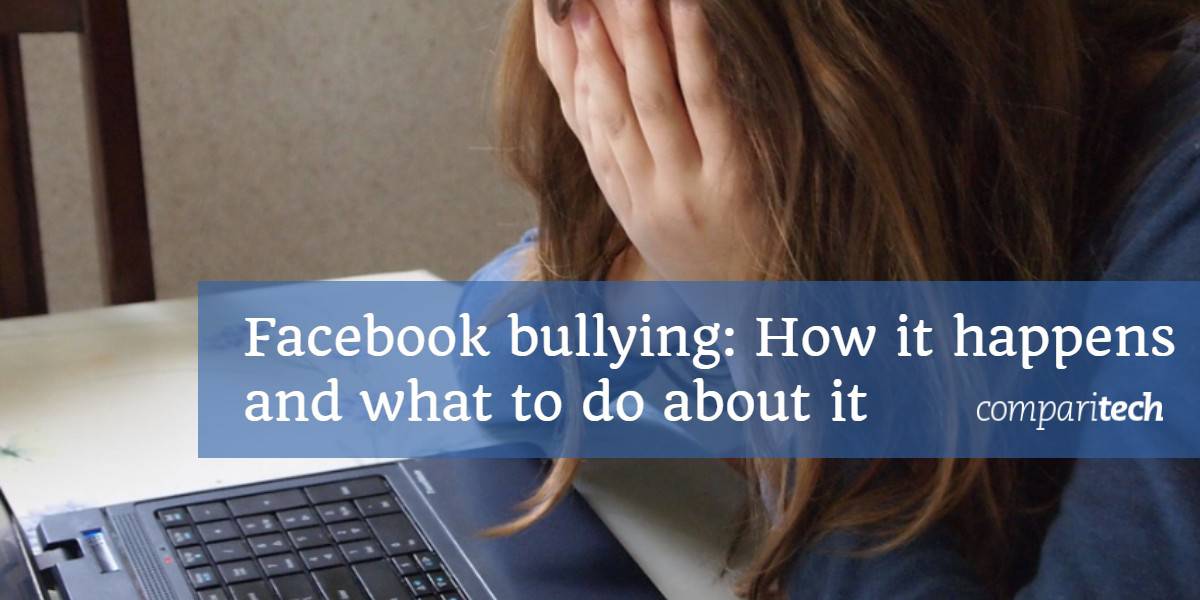
Bullying has been a problem among both children and adults since long before any of us can remember. From small cases to more serious ones, the act of hurting others emotionally or physically is an unfortunate side effect of human nature. The internet and social media platforms like Facebook have given bullies a new forum in which to taunt their victims. And while the landscape is different, the effects can be similar and often worse than those resulting from face-to-face interactions.
Whether you or someone you know is being bullied, or you’re concerned about it happening in the future, arming yourself with knowledge about online bullying can help you avoid or diffuse the situation.
What constitutes Facebook bullying?
Much like bullying that occurs face-to-face, Facebook bullying can take many different forms. Even a seemingly mild bullying offence can have a lasting psychological impact, depending on the person being bullied.
Here are just a few general examples of Facebook bullying:
- Private messages involving derogatory comments or threats
- Public comments within profiles, pages, or posts
- Sharing sensitive or unflattering images or videos of the victim
- Posting explicit or threatening images or videos to the victim’s profile or page
- Pages or groups set up for the purpose of tormenting a victim or victims
- Exclusion from private pages or groups causing the victim to feel left out
Note that bullying doesn’t have to involve words. In many cases, images, memes, or videos are used to make a victim feel bad.
It’s also important to note that Facebook bullying is often not confined to the platform itself. It may be taking place across several social media platforms, and possibly via emails, texts, or face-to-face interactions too.
Cyberbullying statistics
So how prevalent is the issue of cyberbullying on Facebook and other social media platforms? There have been a variety of reports released in recent years, and the results really depend on where and how the studies are carried out. The general consensus though is that most people (adults and children) have been victims of or witness to cyberbullying in some form.
Here are some key finding from various reports.
Safety Net Social Media Cyberbullying Inquiry, 2017
This UK study questioned 1,089 young people, aged 11-25.
- 56% of young people have been excluded from conversations or groups on social media.
- 83% say that social media platforms should be doing more to prevent cyberbullying on their platforms.
- Almost half of the respondents had experienced nasty or threatening social media messages, texts, or emails.
- Two-thirds admitted that if they experienced something upsetting while online, they wouldn’t tell their parents.
2016 Cyberbullying Data from the Cyberbullying Research Center
This US study questioned 5,700 middle and high school students aged between 12 and 17.
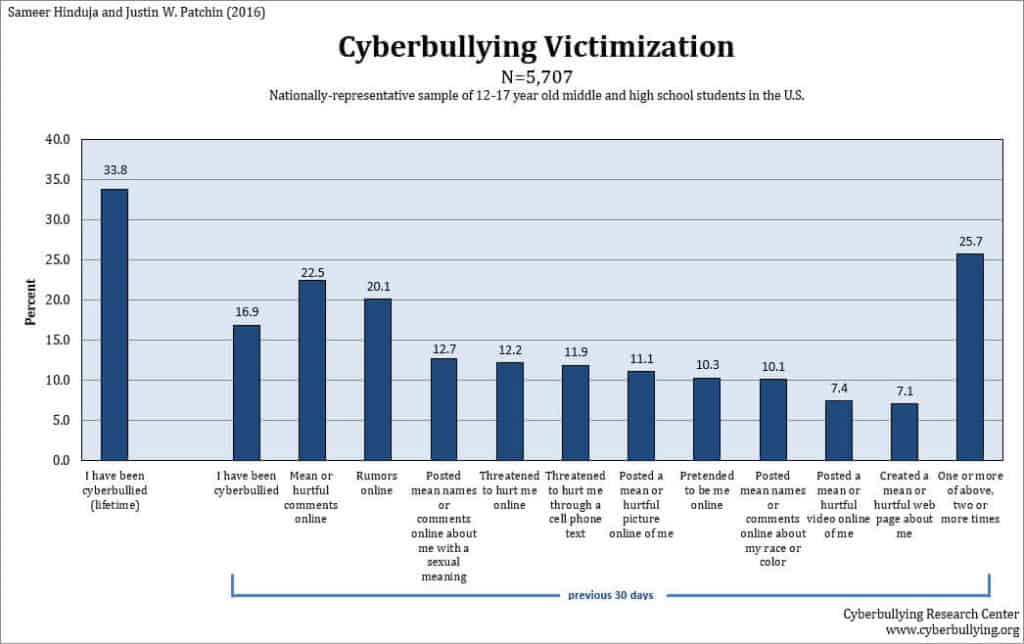
- 34% had experienced cyberbullying at some point in their lifetime.
- 70% had experienced having rumors spread about them online.
- 12% admitted to having cyberbullied others.
- Girls were more likely to have been cyberbullying victims while boys were the more likely perpetrators.
- 64% of those who had been cyberbullied said it affected their learning and their ability to feel safe while at school.
- 83% of those who had been recently cyberbullied (within 30 days) had been bullied recently while at school as well.
Pew Research Center American Trends Panel, 2014
While this study is older, it offers some insight into the world of adult online bullying.
- 73% have witnessed online harassment and 40% report having been harassed online.
- 60% have witnessed offensive name-calling online and 27% have experienced being called offensive names.
- 53% have witnessed someone making efforts to purposely embarrass another person online and 22% have experienced such actions against themselves.
- 25% have witnessed someone being physically threatened online and 8% have been threatened themselves.
- 24% have witnessed sustained online harassment over a period of time and 7% have experienced this firsthand.
- 19% have seen sexual harassment online and 6% have been sexually harassed.
- 18% have witnessed online stalking and 8% have been stalked.
This study also found that men and women suffer different forms of online harassment as shown in the chart below.
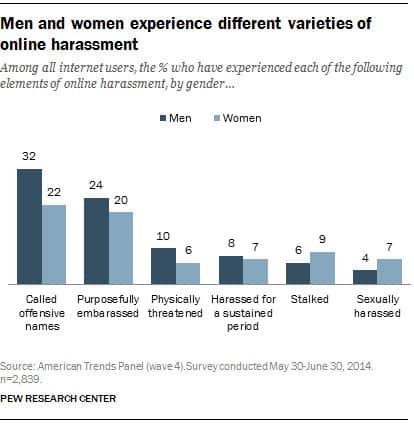
Facebook bullying implications
Although the effects of Facebook bullying can be similar to those of face-to-face emotional bullying, there are a couple of factors that set these two types far apart.
Anonymity
One of the allures of using social media as a platform for bullying is the anonymity factor. While Facebook’s Terms of Service doesn’t allow people to use fake names, it doesn’t actually verify users on signup. As such, it’s very easy for someone to hide their real identity while using the platform.
Over on Facebook-owned Instagram, these anonymous accounts have the name “finstas,” short for “fake Instagram,” but really this is happening across platforms. In some cases, bullies even make accounts in their victim’s name for the sole purpose of ruining their reputation. This means that many would-be bullies who wouldn’t dream of carrying out these acts in a public landscape have a different avenue to pursue.
An alarming and largely unexplained trend that’s surfacing amidst cyberbullying is kids actually cyberbullying themselves. The Cyberbullying Research Center study we discussed above found that six percent of children questioned admitted to creating anonymous profiles for the purposes of sending themselves hateful messages. This has been compared by psychologists to acts of physical self-harm, and dubbed “digital self-harm.”
Regardless of who is doing it, there’s no doubt that anonymity is propagating cyberbullying. Plus, Facebook bullying is not limited to kids; adults bully other adults, and some even bully kids. In particular, there have been a number of examples of parents bullying the kids that have bullied their own.
Access
Before the age of the internet and social media, if someone was being bullied at school or at work, chances are they would find a safe haven upon returning home. Once inside that door, they would be safe from the verbal or physical abuse of their bullies.
However, with social media, bullies can follow their victims home and step right inside, figuratively speaking. With many kids and adults spending their downtime on social media, bullies could potentially torment them from morning to night.
Facebook bullying examples
To better understand what happens in Facebook bullying cases, it’s helpful to look at some real-life examples. There are a plethora of cases and you could probably find some that are ongoing while browsing the platform yourself. Some of these examples are extreme, but they prove that you never really know how far someone will go with cyberbullying.
Also see: Cyberbullying statistics
Derogatory comments and threats
A young Irishman, Darren Hughes, was just 17 when he committed suicide after being bullied via Facebook. His mother reported that he was bullied because of the color of his skin and because he wore a hearing aid. Darren was targeted through “horrific” and “threatening” Facebook messages and his mother has fought to convince the government to do more to prevent similar cases.
Hate groups
Another teen, Kenneth Weishuhn, was bullied at school after coming out as gay, and the torment continued online. Classmates created a Facebook hate group and some even sent him death threats. Unfortunately, this is another case that ended terribly as Kenneth later committed suicide.
Celebrity cyberbullying
Celebrities are far from immune from cyberbullying. In 2017, actress Maya Karin and her family were targeted by cyberbullies on Facebook and Instagram. While the details haven’t been disclosed, the perpetrator reportedly “hurled profanities in Malay and English and made the family fear for their safety.”
She’s not the only celebrity to be targeted. Lena Dunham, Tom Daley, Leslie Jones, Blac Chyna, and many more have been victims of cyberbullying. In the case of Jones, the actress was forced to quit Twitter for a time in response to ongoing harassment. She tweeted:
“I feel like I’m in a personal hell. I didn’t do anything to deserve this. It’s just too much. It shouldn’t be like this. So hurt right now.”
I feel like I’m in a personal hell. I didn’t do anything to deserve this. It’s just too much. It shouldn’t be like this. So hurt right now.
— Leslie Jones ? (@Lesdoggg) July 19, 2016
Sharing intimate videos
Harassment through the sharing of intimate images and videos is a common form of cyberbullying. In South Wales, one woman was horrified as she realized a sex video featuring her had been shared on Facebook by someone she had trusted.
Blac Chyna, mentioned above, was the victim in a case of revenge porn published on Instagram. She has described the anguish she felt after her former partner, Rob Kardashian, shared intimate images and videos as revenge after seeing her kiss another man.
Blue Whale and Momo challenges
As if some of the examples above aren’t enough, if you haven’t already heard about these “games,” they will bring a new level of horror to the world of social media. The Blue Whale challenge and the Momo challenge are similar to each other in that they encourage participants to carry out a series of self-harming acts of increasing danger, ending with the final act of committing suicide.
After two related deaths in the country, India’s government released an advisory about the MOMO challenge in August 2018. It told parents to be aware of the game, but not to speak to kids about it unless they were sure their children were already aware of it. The challenge is said to have started on Facebook, with perpetrators targeting adolescents with suicidal tendencies.
Parents were warned about the Blue Whale challenge (also dubbed A Silent House, A Sea of Whales, or F-57) back in 2016, with the Miami Police Department even releasing a video detailing the dangers. This was in reaction to a string of related deaths.
Cyberbullying laws
In general, there aren’t specific laws that cover cyberbullying. While this is likely set to change as online bullying becomes increasingly relevant, for now, most countries prosecute cyberbullying under existing laws.
USA
Although most states have passed some law or policy related to bullying, these are often up to schools rather than law enforcement to implement. There aren’t any federal laws specifically related to bullying or cyberbullying but some other laws may be used to prosecute in both cases. That being said, it is often difficult to prosecute under a law that’s not designed to cover the specific actions involved in cyberbullying.
One case in the US highlighted the vague nature of laws related to cyberbullying. In 2009, Lori Drew got revenge on her daughter’s bully through a fake MySpace account. The girl, Megan Meier, eventually committed suicide. Drew was originally convicted in the case via the Computer Fraud and Abuse Act on the basis she violated MySpace’s Terms of Service. However, the ruling was eventually overturned.
Currently, the majority of US states have some type of cyberbullying law, but they vary in scope and penalty. One notable law is set to be passed in Michigan. This law would rule the following maximum penalties for cyberbullying:
- First offence (misdemeanor): 93 days in jail and $500 fine.
- Second offence (misdemeanor): One year in jail and $1,000 fine.
- Repeated pattern of bullying causing serious injury (felony): Five years in prison and $5,000 fine.
- Bullying causing death (felony): 10 years in prison and $10,000 fine.
UK
Currently, cyberbullying is not specifically covered by any UK law. However, certain acts that constitute cyberbullying may be punishable under other laws, such as the Protection from Harassment Act 1997, the Malicious Communications Act 1988, the Communications Act 2003, the Obscene Publications Act 1959, the Public Order Act 1986, and the Computer Misuse Act 1990.
It appears that lawmakers are planning to put more of the onus on the platforms themselves. The goal is to introduce statutory codes of conduct which must be followed by platforms like Facebook. If they don’t comply, they could be faced with multimillion-dollar fines. According to UK Culture Secretary, Matt Hancock, he was prompted to get the ball rolling on this legislation after only four out of 14 tech giants sent representatives when invited to discuss the issue of cyberbullying with him.
Canada
Similar to the UK, there are no specific laws related to cyberbullying in Canada. However, according to the Government of Canada website:
“Depending on the exact nature of the behaviour, the following current offences could be charged:
- Criminal harassment
- Uttering threats;
- Intimidation;
- Mischief in relation to data;
- Unauthorized use of computer;
- Identity fraud;
- Extortion;
- False messages, indecent or harassing telephone calls;
- Counselling suicide;
- Incitement of hatred; and,
- Defamatory libel”
The site also discusses in detail that it’s an offence to share intimate images of anyone without their consent.
Australia
In Australia, things are a little more clear. According to the Australian Cybercrime Online Reporting Network (ACORN):
“Under the Criminal Code Act 1995 (Cth) it is an offence to use the internet, social media or a telephone to menace, harass or cause offence.”
This offence carries a maximum penalty of up to three years in prison or a fine in excess of $30,000 AUD.
It’s also noted that stalking laws — which vary between state and territory — may be applied to online behavior. These tend to carry large maximum penalties.
Steps Facebook is taking to prevent cyberbullying
Although cyberbullying is carried out by the social media platforms themselves, there’s’ no doubt that the creators of platforms like Facebook, Instagram, Twitter, and Snapchat have provided bullies with a new forum from which to exert their wrath. As such, it makes sense that many people see social media platforms as facilitators of cyberbullying who should take at least partial responsibility for its prevention.
In the past, platforms have all but shunned this responsibility, but in recent years, the problem has become so prevalent, they’ve had no choice but to step up and do something about it. While many would argue they could still be doing more, there has definitely been progress.
Facebook has a short FAQ section related to bullying and harassment, but this barely scratches the surface. Thankfully, it is seemingly doing more and more to help in the fight against cyberbullying. Here are the main actions it’s taking:
- Bullying Prevention Hub
- Parent Portal
- New tools and features
- Community events
Let’s take a look at each of these in more detail.
1. Bullying Prevention Hub
In 2013, Facebook launched its dedicated Bullying Prevention Hub that was developed in partnership with the Yale Center for Emotional Intelligence. This is described as “a resource for teens, parents and educators seeking support and help for issues related to bullying and other conflicts.”
It offers guides aimed at various parties, including kids being bullied, parents of bullied kids or accused bullies, and educators. The guides cover how to have conversations about bullying and steps you can take to stop it. While this may be helpful in some cases, going through a lot of the literature, it seems to undermine the serious nature of some cases of cyberbullying.
For example, when it discusses actionable steps for a parent to take if their child is being threatened, there is no mention of involving law enforcement. The main piece of advice is to report the offence to the social media platform and talk to a school principal. Given that many cases will involve kids who don’t attend the same school or even live in the same region, the advice seems largely over-simplified.
What’s more, the one piece of advice for people who have been accused of bullying is that they should apologize to their victim. This doesn’t begin to address very serious cases, for example, when a crime has been committed. Surely, in some cases, advice would involve turning oneself over to law enforcement or seeking some form of professional treatment, such as psychotherapy.
2. Parents Portal
The Facebook Parents Portal was rolled out in 2016 and offers parents some basic tips about helping their child navigate social media. While there isn’t a large focus on bullying, there are some helpful sections about online privacy and links to guides for blocking and reporting other users within the platform.
3. New tools
Thankfully, Facebook is taking more actionable steps in a bid to help thwart online bullying.
In 2017, it implemented a couple of new features that could help prevent bullying and harassment.
For example, if you block an account and the user creates a new one, then Facebook will automatically block the new account on your behalf. Of course, this likely isn’t foolproof because it’s believed that Facebook uses IP addresses to identify users. As such, the blocked party creating the new account could simply use a VPN to bypass the restriction. Nonetheless, it’s a step in the right direction.
Another helpful feature that was introduced at the same time was the ability to read a message without the sender being notified that it had been seen.
In addition, in October 2018, Facebook announced that it would implement tools that give users more control over what is posted about them on social media. For example, multiple comments on posts can be deleted or hidden at once, which can help when people are being bombarded with multiple hateful comments.
Facebook will also give people the option to report bullying or harassment on behalf of another user. Another feature Facebook is testing is the option for users to block certain words from appearing in their comments. Facebook-owned Instagram already has an anti-bullying feature that was released in May 2018.
4. Community events
In September 2018, Facebook announced that it will be attempting to tackle cyberbullying head-on in the US by organizing 200 free community events across 50 states. The idea is that the initial events — organized in association with the National PTA — will spark an ongoing forum in which parents can share stories about bullying and learn about how to keep kids safe online.
Although, there’s no guarantee that steps taken by Facebook and other platforms will actually have an effect. Indeed, a recent initiative by Facebook and Snapchat in the UK appeared to fall on deaf ears. The initiative included a recommendation for bullying victims to call a national hotline, but no calls were made as a result.
Cyberbullying prevention and reporting
Unfortunately, there are always going to be bullies in the world and while it would be wonderful if, in the famous words of Rodney King, we could “all just get along,” it doesn’t look like it’s going to happen any time soon.
That being said, there are still steps you can take to help prevent you or someone else enduring more emotional or physical stress as a result of Facebook bullying.
Adjust privacy settings
While it’s not true in every case, accessibility can make a difference when it comes to who bullies decide to target online. Facebook enables you to control who can see your posts, make comments on your profile, and send you friend requests, among other things.
And it’s not just profiles. If you run a page and you want to avoid having to deal with online harassment, it’s possible to stop visitors from posting on your page altogether.
Have a group on Facebook? You can make it private so that unwanted visitors can’t come in and post inappropriate messages.
If you’re a parent, you can help your child navigate social media by going through privacy settings with them and setting some guidelines for using various platforms. You can also employ the use of parental control software such as Qustodio. This enables you to monitor your child’s social media activity, as well as what they’re doing elsewhere on the web.
Avoid sending sensitive information or material online
Many cases of online bullying and harassment involve the sharing of sensitive or private information, images, or videos. Ideally, you shouldn’t be sharing any of this type of material online, in case it falls into the wrong hands.
Unfortunately, unlike many other forms of prevention, this isn’t foolproof. Hackers can get into your computer and steal sensitive files or even take control of your computer camera. There are also cases of revenge porn, as mentioned earlier, where the material was shared with someone the victim had trusted in the past.
Use a VPN
As mentioned, information and material used in online bullying and harassment isn’t always handed over intentionally. Hackers are able to get their hands on your information by other means, such as using man-in-the-middle attacks. These involve internet traffic being intercepted so that a third party can see its contents.
One way to prevent this is to use a Virtual Private Network (VPN). A VPN will encrypt all of your internet traffic so that it is unreadable by anyone who intercepts it.
Unfriend, block, and report
If you are on the receiving end of any unwanted comments or messages, you have several options within the Facebook platform.
First, you can “unfriend” someone. If you have set up your privacy settings correctly, they will no longer be able to see or comment on any of your posts or send you a message. Another measure is to “block” them. This will prevent them from being able to see you on Facebook at all.
Finally, you can report the offender to Facebook. However, there have been reports that people have not received timely responses from Facebook. You may want to pursue other avenues of reporting.
This is especially the case if you have endured or witnessed bullying of a serious nature. In that case, contacting the police is advisable. If relevant, the school should also be notified, although schools have mixed track records for dealing with bullies appropriately.
Document abuse
Although you may want to simply delete unwanted messages or comments as soon as you see them, it’s smart to keep a record of them. One way to do this is to take a screen grab of the message (including the sender’s name and the date stamp) and storing it in a folder on your computer. Then you can go ahead and delete the original comment or message.
This way, if needed, you’ll have your own proof to show whomever necessary. While investigations carried out by Facebook or law enforcement agencies can often recover deleted messages or comments, it’s simpler if you have your own record to refer to.
Image credit: “Bullying” licensed under CC BY 2.0

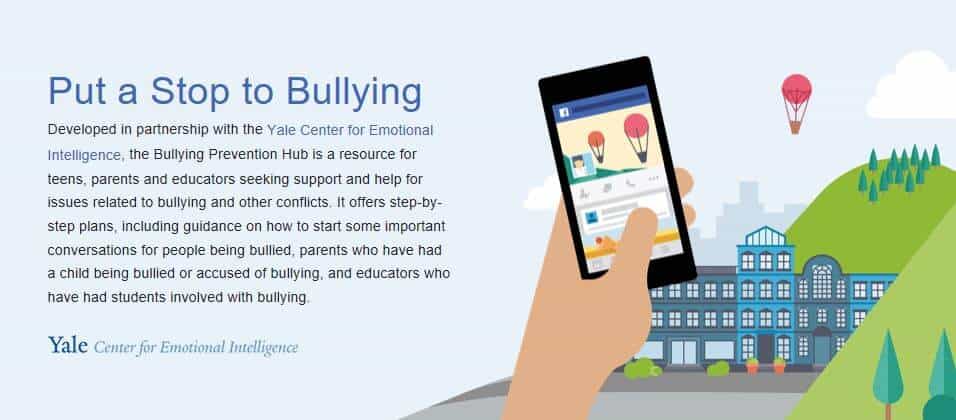
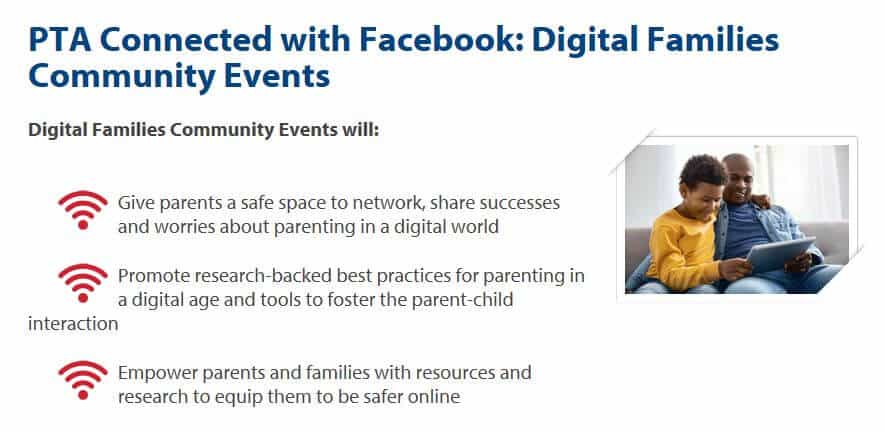
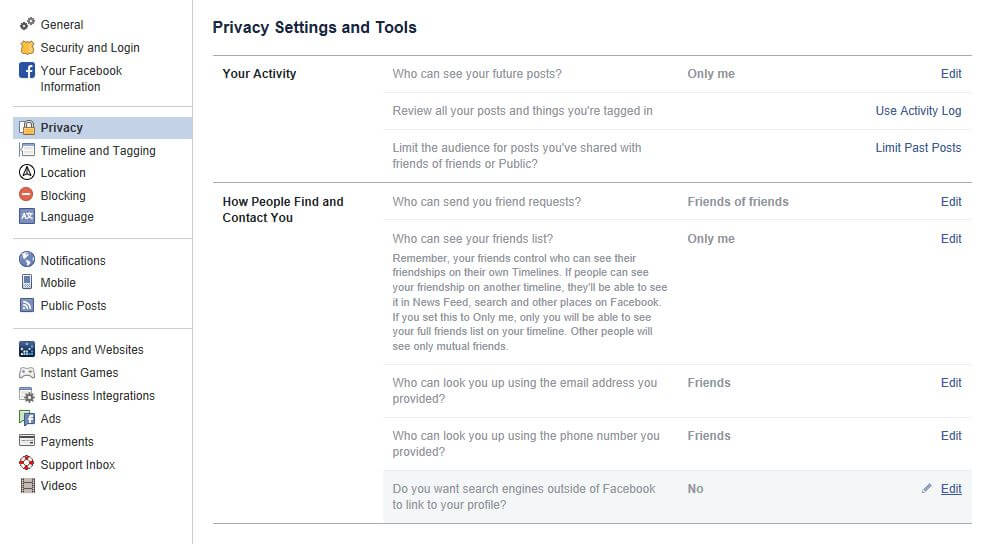
Facebook is a bully itself with NO ethical compass and no social conscience. Cannot even effectively block hate soeech, misinformation or disinformation. It’s actions today in Australia affirm it’s tawdry irresponsible conduct. Money usurps social responsibilty !! Shame on you Facebook
Social Media bullying also happens to adults. Particularly adults that may be vulnerable in some way; poverty, disability, or a loner in general.
Somehow adults believe it is acceptable to bully and harass other adults on social media.
Facebook recommends that you report specific post, however, if you are excluded from the group you have no access to the post and thus are barred from that option. There is no way to contact FB about this so you will have to except that you are excluded from the group without recourse even though it had been recognized that bully use exclusion from a private group and a method to attack you. Furthermore, FB has removed many of the resources and contact methods and put you in a circular maze of information that never gets you to anyone in FB that can take action. The FB bully groups have little help in the resource area and are mostly there for emotional support.
My email and Facebook passwords were changed as they were known by the abuser. What can I do as this is escalating to physical verbal bulling and criminal damage.
If a crime has taken place, you should report to police.
Been through this myself it’s awful I have no words I was left very suicidal with online bullying I had it for many years fake names my account was hacked into 4 times. The name calling rumor spreading and slandering just so awful
Hi .. someone from italy harrassing me and doing lots of bullying on fb .. she use my picture and name on fb and putting nasty things about me.. needs help badly .. please.. it has been going on for few mo ths already
Sorry to hear you are experiencing this. Report the case to Facebook and to local law enforcement if you deem necessary. Keep documentation including screenshots of what is posted, so that you can present to Facebook or police.
One can not report this to Facebook as they have disabled the ability to report someone for harassment. The closes thing they have to this is “Posting something inappropriate”. There is also no way to contact Facebook in an interactive way, it is all one way and there is not reasonable feedback on results that indicate that they will not help. They do not provide enough detail and there is no way to respond back.
Hi,
I agree, FB is frustrating, more and more I see instances all the time involving completely innocuos posters being insulted or demeaned for no reason whatsoever. I am very discouraged with FB. I am going to change to a different social media platform where there is better security and more observance of a code of conduct.i am discouraged because I know how FB works and it has many assets. But the constant rudeness is not worth it.I do not know where are these disturbed posters on FB come from.Is it the world’s prison population posting on FB? Or are there so many antisocial people in our society who feel free to use social media to damage others? the fact that there will be no punishment? it is scary to think that so many people full of hate exist.Kate
I’m not even on Facebook anymore due to terrible things being said about me. The same person has this weekend started posting stuff on my daughters wall about me. (I have never met this person she is my ex husbands gf) She was banned for harassment a while ago for harassing me. She also made fake profiles in my name and used my photos in the end I deactuvated. Now she’s started again. There is no way to contact fb to ask them to tell her to stop. She uses a fake name and deactivates so fb can’t locate her.
Hi Jane,
You are not alone in this kind of situation. It sounds as if distance may be a solution.Ie, cut the strings.There are good alternatives to facebook now. Get away from people who choose to harrass you. Choose peace of mind and do what is best for you.Leave any platform where harrassment has happened and set up a new account in different social media.Eventually your harrasser will give up.Put the past to rest and choose a bright new future for you!!!
It would be worth collecting evidence of this harassment and reporting it to police.